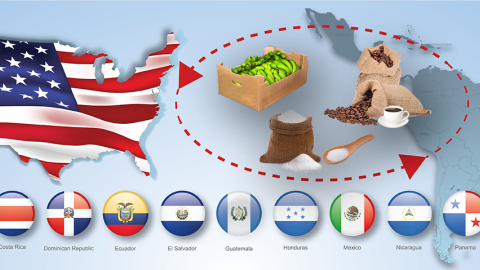In most foreign markets, long-term consumer spending trends show declining expenditure shares for staples (like rice and wheat) and increasing shares for higher value food items—such as meat, dairy, fruits, and vegetables. These shifts in food-demand trends have reshaped global food marketing and prompted changes in the global food-industry structure. Food suppliers and retailers have responded to demand by modifying their products and retail formats to better meet consumer needs. Additionally, multinational retailers have expanded in developing countries. Moreover, the global-food industry structure has been changing as manufacturers and retailers adjust to meet the needs of consumers, who are increasingly demanding a wider variety of higher-quality products.
ERS analyzes data collected by various national and international organizations—including U.S. trade data from the U.S. Department of Commerce; United Nations trade data; consumer expenditures and other economic indicators from the World Bank—and Euromonitor International data, a commercial vendor, to examine the ongoing evolution of global-food markets and consumption patterns.
Data on expenditures on food and alcoholic beverages in selected countries
An assessment of food demand and the level of per capita consumer expenditures across countries is a valuable tool for all individuals involved in the agricultural sector. Low-income countries allocate a greater portion of per capita income to food. As countries become more affluent, more of their disposable income is allocated to other categories. The tables contain data on food expenditures (including nonalcoholic beverages), alcoholic beverages, and tobacco as a share of consumer expenditures on all goods and services for 104 countries. The tables also contain data on per capita consumer expenditures on goods and services, as well as per capita food expenditures for these countries. All expenditure data are in current U.S. dollars.
Data on expenditures on food and alcoholic beverages in selected countries are available here
Data on international consumption trends
International Food Consumption Patterns database (This data product is no longer being updated) presents income and price elasticities and marginal shares for 9 major consumption groups and 8 food subgroups across 144 countries, using 2005 International Comparison Program (ICP) data. Also available: estimates for 114 countries based on 1996 ICP data.
ERS publications on international consumer and food industry trends
- Economic Crises and U.S. Agricultural Exports A USDA, Economic Research Service (ERS) model of world agriculture and trade recently projected that if a major economic crisis were to simultaneously hit the eight largest foreign markets for U.S. agricultural goods, total U.S. exports of grain and oilseed products would decline by 6.8 percent ($2.4 billion), and total U.S. exports of meat would drop by 7.3 percent ($0.7 billion), using import volumes in 2018 as the base. Effects of world economic crises on U.S. exports have occurred before. For example, during The Great Recession of 2007–09, agricultural imports from the United States collectively fell by 17 percent, from $83 billion to $68 billion, in 7 large foreign markets hit by the crisis—including Japan, China, the European Union, and Mexico. This was made possible in several ways. Economic crises often result in consumers earning a lower income in the affected countries, which can lead to decreased demand for imported products. Additionally, a crisis can weaken crisis-afflicted countries’ currencies against the U.S. dollar, making U.S. imports more expensive for foreign markets.
- China's Refusals of Food Imports Compliance with China’s food standards and regulations can be a challenge for exporters aspiring to sell China’s growing markets. China’s demand for food imports has grown over time as demand for diverse foods has increased, rising 12 percent from 2006 to 2019. China’s import refusals have fluctuated year-to-year, hitting the highest percentages of refusals in 2007 and 2017 . While the number of rejected shipments declined to their lowest-ever totals in 2018 and 2019 , food coming from less-developed nations—such as Vietnam, India, and Thailand—have experienced increased scrutiny. Processed, consumer-ready foods and beverages (like wine) are among the main items that have not met Chinese import inspectors’ requirements.
- New International Evidence on Food Consumption Patterns: A Focus on Cross-Price Effects Based on 2005 International Comparison Program Data This report presents cross-price elasticities for 9 major consumption categories across 144 countries, using 2005 International Comparison Program (ICP) data. Cross-price elasticities are also reported for a two-good demand system based on food and nonfood items. This report builds on an earlier ERS report, International Evidence on Food Consumption Patterns: An Update Using 2005 International Comparison Program Data (see link below), which presents expenditure and own-price elasticities for nine major consumption goods as well as for eight food subgroups. Data presented in the report on cross-price elasticities are available here.
- International Evidence on Food Consumption Patterns: An Update Using 2005 International Comparison Program Data Findings within this report have confirmed earlier studies that show low-income countries spend a greater portion of their budget on necessities, such as food, whereas higher-income countries spend a greater proportion of their income on luxuries, such as recreation. Low-value staples, like cereals, account for a larger share of the food budget in low-income countries, whereas high-value food items (e.g. preserved fruits) make up a larger share of the food budget in high-income countries. Overall, low-income countries are more responsive to changes in income and food prices and, therefore, make larger adjustments to their food consumption patterns when incomes and prices change.
Both reports mentioned above build on the modeling approaches presented in International Evidence on Food Consumption Patterns and in Cross-Price Elasticities of Demand Across 114 Countries.
- Convergence in Global Food Demand and Delivery and Converging Patterns in Global Food Consumption and Food Delivery Systems This report and article show changes in food-consumption patterns are largely driven by income growth and demographic factors, particularly lifestyle changes brought about by urbanization, women’s away-from-home employment, and increased levels of information. Although income growth is one of the most important factors contributing to demand changes, urbanization has been equally important in changing food-consumption trends. Economic growth can indefinitely continue and go in cycles. However, urbanization has, so far, been a one-way process with the rural share of the population eventually becoming so small that urbanization is no longer an important factor in projecting food demand, which has been occurring in developed countries. Among developing countries, large shares of rural populations and rapid urbanization rates, urbanization is expected to significantly alter consumers' diets with greater consumption of meats, fruits, vegetables, and processed-food products.
- Where Will Demographics Take the Asia-Pacific Food System? Fifteen Pacific Rim countries contributed to the original report, which was jointly sponsored by the Pacific Economic Cooperation Council, ERS, the Farm Foundation, the East-West Center, and the College of Tropical Agriculture and Human Resources at the University of Hawaii.



